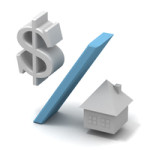As investors, our greatest aim is to keep diversifying our portfolio. Diversification can help absorb losses made on a particular property better. Ideally, every seasoned investor wants to have a very high ratio of profitable properties in his/her portfolio mix. However, is it an easy goal to attain, especially when there are so many factors that can test the property market economy?
Find out some of the major factors that will affect your property investments, including one that is regularly overlooked by most.
12 factors affecting property prices
Certain conditions raise property prices and others bring them down. So it is definitely worth it to keenly observe the reasons which may influence property prices. Here is a list of 12 of the most significant factors, all of which can have a direct bearing on the profit of your portfolio.
The infographic sums up the article for you. Scroll down beyond it to read in more detail about how each of these factors influence the price of property in Sydney and across Australia.
1. Capital growth rate can affect property prices
With a rise in household income, property prices are only expected to rise. This is why it is a wise idea to work on the inflation-adjusted capital growth rather than the nominal growth. The inflation-adjusted capital growth can be tardy, average, good, or even phenomenal. How an area has performed historically can also affect its prices.
Effect on the property market- The above factor can increase property prices by 100% in 5-7 years.
2. Capital gains tax can affect the property market
Capital Gains Tax (CGT) increases government revenue but this comes at a major economic cost. CGT, even the discounted one, brings down the return on investment and hence affects investors and entrepreneurs monetarily and psychologically. This can translate into reduced reallocation of capital and can hamper available stock (creating undersupply).
It is notable that CGT is only applicable on realisation of profit. So there is no CGT event if investors decide to retain their assets. This works as an incentive for investors and they often end up retaining sub-optimal investments, thereby letting go of better opportunities. The lock-in-effect harms the economic output, affecting the property market in particular and the economy in general.
Empirical evidence suggests that there is a definite relation between the way capital gains tax is treated in a country and the venture capital flowing into it. The conclusions drawn are crucial for the property market. Decreasing CGT, after all, can lead to a rise in investment. Higher redistribution of capital would then mean constant cushion to the supply side, thereby keeping the property market away from questions of affordability.
Effect on the property market- Decrease in CGT can boost investment and reallocation of capital, hence impacting the property market by hundreds of millions (over the long-term).
3. Property investment can be hit by the impact of overseas buyers
 Overseas buyers can only involve themselves with new properties (though they are buying existing properties illegally) and that is a pretty small component of the housing market (dominated by established properties). This said, many buyers looking for a safe haven in Australia (and Sydney in particular) have enough money to change the dynamics of real estate investment. Their entry in hordes often result in increased prices- enough to elbow out at least the first home buyers from the race).
Overseas buyers can only involve themselves with new properties (though they are buying existing properties illegally) and that is a pretty small component of the housing market (dominated by established properties). This said, many buyers looking for a safe haven in Australia (and Sydney in particular) have enough money to change the dynamics of real estate investment. Their entry in hordes often result in increased prices- enough to elbow out at least the first home buyers from the race).
Effect on the property market- The above factor can increase worth of real estate by billions (bringing questions of affordability).
4. Real estate prices may be determined by urbanisation
If you take a look at the gentrification trends of the previous decade, you will notice that certain areas have urbanised faster than the others. Because people migrating to such places seek comforts like the café lifestyle, smooth transport, various modern day amenities and facilities, the property developers in these areas have to factor in all these aspects into their final prices.
Also, the ‘resident’ population today does not mind departing from the concept of detached houses to apartment living and for them, at least the idea of a McMansion in the suburbs (precious to our past generations) has certainly become a thing of the past. Given this change in preference, prices of medium-density dwellings have also witnessed a sea change.
Effect on the property market- The above factor can increase prices of individual properties by at least 30%.
5. Negative gearing influences price of properties

Certain investors look for positive cash flow through positive gearing. On the other side of the spectrum, there are investors who look for high capital growth by opting for negative gearing. Negative gearing encourages demand and by changing the supply-demand dynamics, it raises prices. While negative gearing has resulted in a price rise in Melbourne and Sydney, blaming it entirely will be a wrong approach.
There was a time–as recently as 1999–when landlords made a profit of $220 million. Today, they are incurring a loss close to $7 billion because the concept of negative gearing appeals to them.
Government is losing something in between $5 billion to $9 billion in taxes but what is more significant to note is that only about 7% of the investments are pouring into building new houses, and the remaining 93% is going into pushing the price of existing properties even higher.
Foreign investors are laundering misappropriated funds by investing illegally in established properties. Unless the structure surrounding such foreign investments is modified and the capital gains tax discount is reformed, taking away/keeping negative gearing won’t change anything at all.
Effect on the property market- The above factor can inflate price levels and spike real estate worth by hundreds of millions.
6. Rental vacancy rates can take yields off-balance
When investment properties remain vacant for long, rental yields are affected and since, in any given stage of the property cycle, the performance of rental yield and capital growth are not exclusive to each other, property prices are affected just the same.
Effect on the property market- The above factor can bring down or take up prices of individual properties by 30% (depending on how far the problem has spread into the neighbourhood).
7. Property prices may be affected by zoning restriction
Sometimes, the government restricts an area from undertaking residential development and at other times, earmarks an area only for residential apartments and dwellings, denying commercial development. Land-use restrictions have a big impact on the value of the land and subsequently on the value of the property developed on the land.
Zoning can have an indirect effect on the land value as is the case when it affects the rental value. It can also have a direct effect; which is the case when it alters tax rates (and they get capitalised into the value of the land).
Effect on the property market- The above factor can affect prices by thousands of dollars both ways.
8. Best suburbs in Sydney may not have diverse growth factors
A few suburbs may show a great deal of promise today, but for all we know, time might tell that they were not really strategically located. A great example would be those suburbs which gained a lot from the mining boom, then suffered from real estate depression when the mining boom wore off. What was the reason behind it? The main reason was the lack of multiple drivers of economy.
Had those same suburbs also included other factors of growth except mining, their property market could have rallied better against the mining wear-off. So, in short, property prices may also depend (in the long run) on the number of drivers a local economy has.
Effect on the property market- The above factor can make a difference of at least 30% in property values
9. Real estate values can be impacted by low interest rates
 The Australian government slashed interest rates to bring back sanity in the property market. The idea was to take the economy from the shoulders of the mining sector to the shoulders of the construction sector. The move has worked well. Real estate values have marched ahead, especially in the capital cities of Sydney and Melbourne.
The Australian government slashed interest rates to bring back sanity in the property market. The idea was to take the economy from the shoulders of the mining sector to the shoulders of the construction sector. The move has worked well. Real estate values have marched ahead, especially in the capital cities of Sydney and Melbourne.
The question we face is a rather tricky one: buyers have a greater incentive to buy as they have lesser mortgage liability to pay. With greater demand, prices of properties are only expected to rise. Up to this point, it is easy to decode, but what happens when the interest rates correct themselves? Think!
Effect on the property market- The above factor can increase cumulative property prices by tens of millions.
10. Department of housing must define oversupply/undersupply of development-ready stock
Housing approvals are increasing and both detached dwellings and apartment units are being constructed at a ferocious pace, but the under-supply of development stocks is pulling the rug from under the economy’s feet. Investment-grade stocks are different from what, for instance, a first home buyer might require. Not addressing this area can hurt investors and prices hard.
Effect on the property market- The above factor can introduce questions of affordability. Estimated impact- tens of millions.
11. Sydney property market trends show the impact of population explosion
 Lately, net interstate migration, the search for a safe haven, and greater life expectancy has made cities like Sydney and Melbourne witness a population explosion. Housing supply has not been able to keep pace with population growth and this has resulted in a chronic housing crisis and raised unwanted questions of affordability in regards to Sydney property prices.
Lately, net interstate migration, the search for a safe haven, and greater life expectancy has made cities like Sydney and Melbourne witness a population explosion. Housing supply has not been able to keep pace with population growth and this has resulted in a chronic housing crisis and raised unwanted questions of affordability in regards to Sydney property prices.
Effect on the property market- The above factor can result in chronic housing shortage. Estimated impact- tens of millions.
12. Sydney property prices depend quite a bit on time-on-market stats
When properties fly off the market shelves in little time, it implies that a seller’s market is prevailing and that the buyers are ready to pay anything. Naturally, it raises the property prices. The opposite phenomenon can be witnessed when high vendor discounts are being offered to keep the buyers interested.
Effect on the property market- The above factor can increase or decrease prices of individual properties by 20%.
So we find out that there are several factors at play
There are several forces at play here, and it is not easy to plan for all of them. In fact, some of them are beyond our control. For instance, it is for the government to adopt new policies of land-use, reform capital gains tax discount, restructure negative gearing or cater to undersupply of development stock. However, there are other factors over which we have enough control.
Which location did we invest in? Did we conduct Due Diligence with regards to the comparable sales figure, slope/orientation/floor plan/renovation-worthiness of our prospective property? Did we ponder over the history of capital growth, gentrification trends and zoning restrictions?
As a buyer’s agent, I always aim for the broadest perspective when it is time to choose a property for my clients. It is wise to factor in all the aspects that may hit property prices in months or years to come. If you are considering purchasing a home in Sydney’s Eastern Suburbs, why not contact me today and get me to assist you?













